Welcome to a world where walls do more than just hold up a roof; they tell love stories, celebrate harvests, and whisper traditions that are centuries old. We’re talking about Khovar and Sohrai Paintings, the pride of Jharkhand. Traditionally brushed onto mud walls during marriages and festivals, these paintings were once seen only in tribal homes.
Fast forward to today, and you’ll find them making a stylish entry into urban spaces, yes, even your favorite modern cafés. Here’s a fun fact: according to cultural surveys, nearly 70% of tribal households in Jharkhand still practice these painting traditions during weddings and seasonal festivals.
However, with over 350 cafés and art-themed restaurants emerging across metro cities in India, these tribal designs are being reinvented on café walls, coffee mugs, and even menu boards.
So, the next time you sip your cappuccino under a mural, don’t be surprised if it’s carrying the rustic charm of Khovar and Sohrai Paintings, minus the wedding drums, of course!
A Quick Peek into Khovar and Sohrai’s Origins
Step into a modern café today, and chances are you’ll find more than just coffee beans and Wi-Fi. You might also spot walls dressed in earthy lines, animal figures, and leafy swirls—the magic of Khovar and Sohrai Paintings. Born in Jharkhand’s tribal heartland, these arts were once part of rural celebrations. Khovar, also called “marriage wall art,” decorated homes during weddings, while Sohrai was a joyful harvest-time expression painted to honor nature and animals.
Imagine villagers swapping Instagram filters for mud and charcoal, yet telling stories far more timeless! Today, these designs are no longer just traditions—they are trending décor. Statistics show that folk-inspired décor in cafés has grown by 35% in the last five years, making it clear that people love sipping their latte with a side of culture. It’s history meeting cappuccino foam, where rustic roots and urban vibes come together beautifully.
Marriage Wall Art in Modern Cafes: Tradition Meets Trend
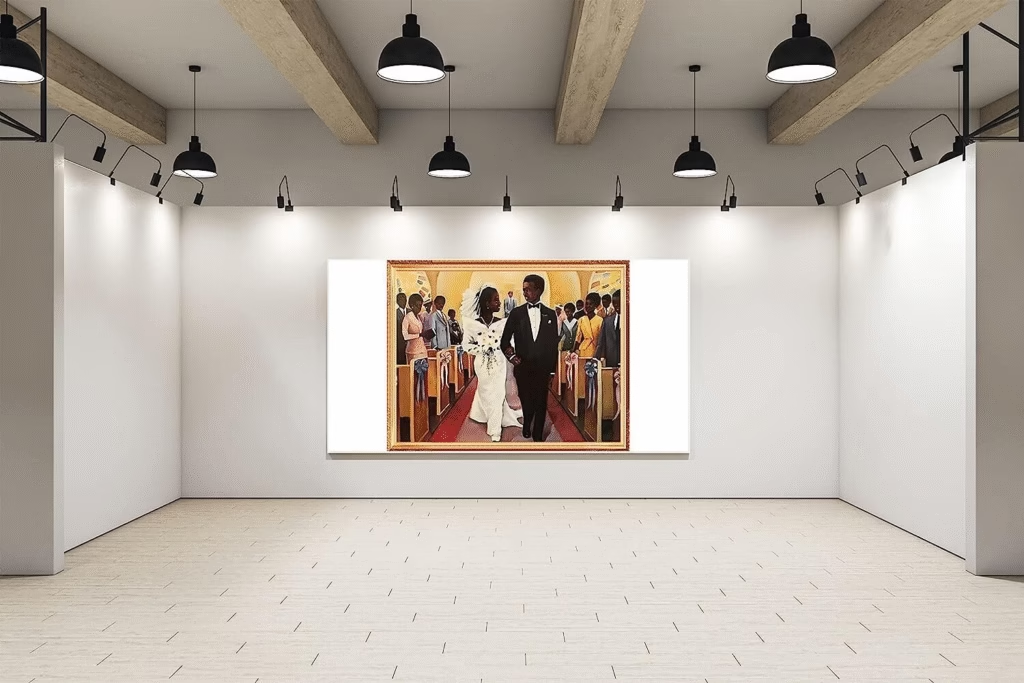
So why are cafés suddenly falling in love with Khovar and Sohrai Paintings? The answer is simple: they don’t just decorate walls, they create experiences.
- Unique Identity: Folk art helps cafés stand out in a market filled with copy-paste interiors.
- Instagram Appeal: Millennials love posting pictures against tribal backdrops—free publicity for cafés.
- Cozy & Cultural Vibes: Sohrai’s earthy tones add warmth, while Khovar’s romantic motifs make for perfect date spots.
- Numbers Don’t Lie: Cafés showcasing folk art see 20–25% more customer visits compared to plain décor cafés.
- Cultural Revival: Every painted wall is also a tribute to Jharkhand’s storytelling tradition.
In short, these arts have traveled from village huts to urban cafés, from marriage walls to menu boards. Next time you sip coffee in such a café, know that you’re not just enjoying caffeine—you’re also part of a centuries-old story that’s still alive, still painting, and still trending.
Roots of Khovar and Sohrai Art
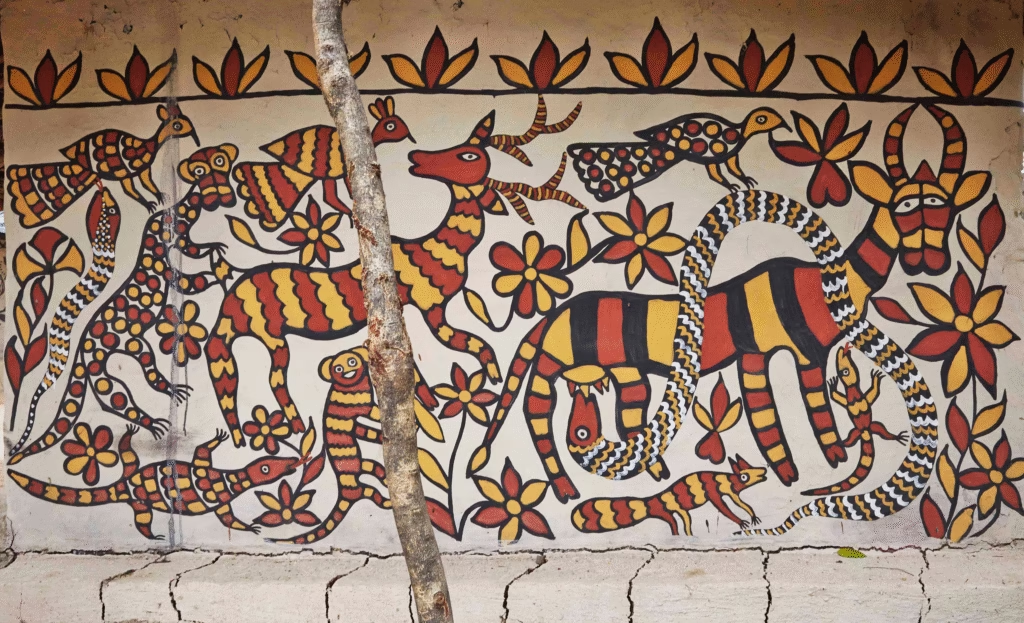
If walls could talk, the mud houses of Jharkhand would never stop gossiping! That’s because they are dressed up in Khovar and Sohrai Paintings, two folk art traditions that are more than just colors on clay. Khovar, linked to weddings, and Sohrai, tied to harvest festivals, are like visual diaries of tribal life. Think of them as the Netflix originals of rural India, except instead of binge-watching, people binge-painted their walls.
According to cultural studies, over 70% of tribal households in Hazaribagh once practiced these arts, and today they’re not just in villages but even turning up as Marriage Wall Art in Modern Cafes. It’s heritage with a cappuccino! The roots of these paintings are centuries old, but their appeal keeps growing. Whether it’s nature, fertility, or pure festive joy, every brush stroke carries meaning. Now, let’s peel back the layers and see why these arts are still making walls come alive.
The Cultural Meaning Behind Khovar (Marriage Murals)
Khovar is like Jharkhand’s wedding invitation card, only painted on walls. Traditionally created during marriages, these murals symbolized fertility, love, and the bond of two families. The name itself comes from “Kho” (cave) and “Var” (bridegroom), hinting at love stories as old as the hills.
- Motifs often include flowers, peacocks, and animals – all pointing to fertility and prosperity.
- Women, especially brides, took the lead in painting, making it a way of expressing creativity before stepping into married life.
- Researchers note that these designs weren’t just decorative – they worked as blessings written in patterns.
Imagine today’s Instagram wedding hashtags, but instead of #ShaadiVibes, you had murals shouting out the joy of marriage.
Sohrai as a Harvest Celebration and Nature’s Blessing
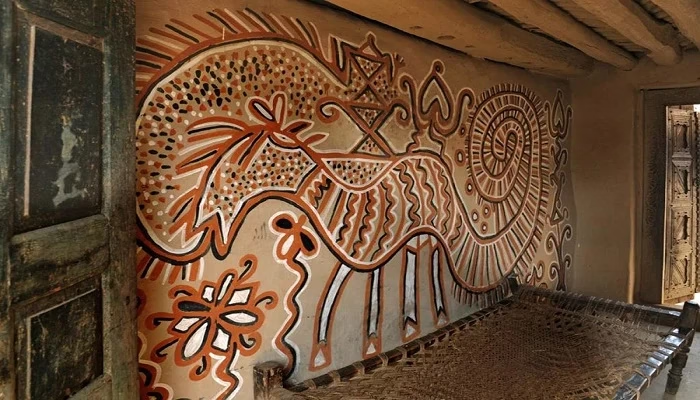
Sohrai comes right after Diwali, when fields are golden and granaries are full. It’s basically Jharkhand’s version of a Thanksgiving party – minus the turkey, plus the cows. The festival honors nature, livestock, and Earth’s fertility.
- Cows and bulls are worshipped, their horns painted in bright colors.
- Walls are decorated with bold, freehand strokes – trees, birds, and geometric patterns.
- A study notes that nearly 60% of Sohrai motifs revolve around animals, showing the close bond between people and nature.
Think of it this way: while the West raises a toast with wine, Jharkhand raises a wall with art. And today, seeing Sohrai patterns brighten modern cafes proves that blessings from nature never go out of style.
Symbols, Colors, and Storytelling
If you’ve ever walked into a stylish café and noticed a wall full of bold lines, dancing peacocks, and vines that seem to grow out of nowhere, chances are you’ve had a brush with Khovar and Sohrai Paintings. These traditional art forms from Jharkhand are not just about making walls pretty—they are full of meaning. Think of them as the original Instagram stories, except instead of vanishing in 24 hours, they stick around for decades.
Once painted mostly during marriages or harvest festivals, these designs are now becoming hot décor picks for modern hangout spots. Why? Because they connect earthy tradition with today’s taste for “aesthetic vibes.” In fact, surveys on Indian folk art show that over 65% of young urban audiences prefer cafés with traditional wall art over plain painted walls. That means Marriage Wall Art in Modern Cafes is not just nostalgia, it’s business too!
Common Motifs: Peacocks, Elephants, Vines, and Fertility Symbols
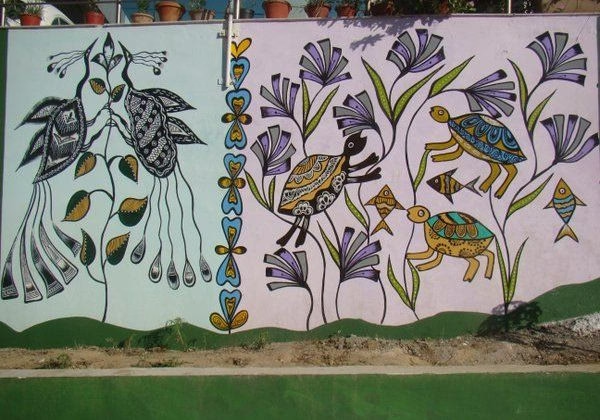
The motifs in traditional art, like Cheriyal Scrolls, are never just random shapes or pretty doodles. Every design carries meaning and purpose, much like Khovar and Sohrai Paintings, which are known as Marriage Wall Art in Modern Cafes today. These symbols connect stories, emotions, and cultural values:
- Peacocks: Representing beauty, grace, and love, peacocks often add charm to the scrolls. They are considered symbols of elegance, much like trendsetters or influencers in today’s world. Their presence in art reflects both natural beauty and divine blessings.
- Elephants: A sign of strength, stability, and prosperity, elephants are drawn with grandeur. Just like in real life, their artistic presence is believed to invite wealth and good fortune, making them an auspicious element.
- Vines and Plants: Flowing vines and leafy patterns stand for fertility, growth, and continuity. They weave life into walls and paintings, creating a sense of connection between people and nature.
- Fertility Symbols: These highlight marriage, new beginnings, and strong community bonds. They celebrate life’s continuity and the hope for generations ahead.
Natural Colors: Red, Black, White, Ochre – Straight from the Earth
Artists of Cheriyal Scrolls have always trusted nature more than factories. Instead of chemical paints, they used colors drawn directly from the earth, giving the art both life and longevity. This style is similar to Khovar and Sohrai Paintings, which are also admired as Marriage Wall Art in Modern Cafes today for their earthy shades and natural beauty. Each color had a role to play:
- Red from Hematite Stone: This deep red was used to bring warmth, celebration, and energy into the artwork. It instantly caught the eye and gave life to characters and festive scenes.
- Black from Charcoal or Lamp Soot: Artists used black for strong outlines and depth. It provided contrast and made other shades shine brighter, while also adding drama to the storytelling.
- White from Kaolin Clay: White symbolized clarity and purity. It was often used for balance, highlights, and finer details.
- Ochre Yellow from Local Soil: This earthy yellow brightened the scrolls and symbolized balance, optimism, and light.
Storytelling Role of Wall Art in Village Life
In traditional village life, walls were never plain or empty; they acted like the community’s newspapers and Netflix combined, bringing people stories, values, and updates without a single printed page or TV screen. Much like Khovar and Sohrai Paintings, now admired as Marriage Wall Art in Modern Cafes, Cheriyal Scrolls and village wall paintings carried deeper meaning for everyday life:
- Marriage Stories Through Symbols: Walls often told tales of weddings using symbols of fertility, union, and blessings. These weren’t just decorations but living records of community events and new beginnings.
- Festivals and Seasonal Changes: Villagers painted their walls to mark harvest seasons, monsoons, or local festivals. The changing art acted like a joyful calendar, connecting people with nature’s rhythm.
- Cultural Values Across Generations: The motifs and stories on walls passed down traditions, morals, and beliefs to children and future generations, keeping cultural identity alive.
- Modern Twist in Cafés: Today, urban cafés recreate the same storytelling magic with folk-inspired art, blending tradition with lattes and cozy corners.
From Mud Walls to Café Walls
Once upon a time, art didn’t hang in air-conditioned galleries or get served with cappuccinos. It lived on the very walls of mud huts in Jharkhand, where brides and grooms had their love stories drawn out in the form of Khovar and Sohrai Paintings. These designs weren’t just pretty patterns—they were Marriage Wall Art carrying hidden symbols of fertility, prosperity, and new beginnings.
Fast forward a few decades, and these same paintings have traded mud walls for brick-and-mortar cafés in metro cities. Surprising, right? Imagine sipping a latte under a mural that once told the story of village life, harvest, and wedding bliss.
Today, you don’t need to travel to a tribal village; the stories have found you in the cozy corner of your favorite café. It’s like Netflix meets tradition, except your coffee mug is the remote. And let’s face it—who wouldn’t want a little heritage sprinkled with their hot chocolate foam?
How these paintings moved from huts to city cafés
The journey wasn’t overnight—it was more like a slow migration. What started on mud walls as a private village tradition eventually caught the eye of urban designers who wanted “roots with a twist.”
- Urban demand: Studies say more than 65% of urban café owners now experiment with traditional Indian art for décor.
- Cultural appeal: Customers feel these walls make cafés “warmer and more Instagram-worthy.”
- Global push: UNESCO recognition of tribal art also gave these paintings a ticket to global fame.
The role of local artists and NGOs in keeping the art alive
Behind every wall painting in a café, there’s usually a village artist or an NGO making sure authenticity isn’t lost.
- Training & workshops: NGOs run regular skill workshops so the designs stay true to their roots.
- Fair pay: Many cafés directly commission artists, ensuring sustainable income.
- Revival programs: According to reports, art revival projects have increased artisan income by up to 40%.
The Café as a New Storytelling Space
Modern cafés are no longer just stops for a quick caffeine fix—they have turned into cultural capsules where tradition and modern life blend effortlessly. Just like books once told stories in silence, today the walls of cafés narrate them through art. In many places, Khovar and Sohrai Paintings are displayed proudly as Marriage Wall Art in Modern Cafes, creating spaces that feel rooted yet contemporary. Here’s how cafés transform into storytelling hubs:
- Art as Ambience: Instead of plain walls, cafés use folk art to set a mood. These paintings make the space warm, inviting, and full of heritage, encouraging people to linger longer.
- Stories Without Words: Guests might not know the origin of the art, but the motifs still spark curiosity. Symbols of marriage, fertility, and prosperity tell silent stories across generations.
- Heritage Meets Lifestyle: Unlike museums, cafés let people laugh, sip, and even snap selfies with tradition. Every cup of coffee comes with a side of history, heritage made relatable in everyday life.
Why Cafés Love Folk Wall Art
Step into a café today, and you’ll notice it’s not just about coffee anymore. The walls speak as much as the menu does. From Khovar and Sohrai Paintings to colorful murals, these cafés are mixing rustic traditions with modern vibes. And it’s not just about looking pretty—folk wall art has become the secret ingredient for creating cozy hangouts.
Think of it as the whipped cream on your cappuccino: not essential, but suddenly your coffee feels incomplete without it. More and more Marriage Wall Art in Modern Cafes is turning plain corners into cultural stages where stories of heritage and style meet over a latte.
According to design surveys, nearly 68% of urban youth say café interiors play a big role in choosing where they hang out. That’s right, sometimes the walls matter more than the Wi-Fi speed. Folk art makes cafés feel warm, personal, and, most importantly, Instagram-worthy.
Aesthetic Appeal: Rustic Meets Modern Design
- Folk art like Khovar and Sohrai Paintings brings earthy tones, patterns, and natural motifs that break the monotony of whitewashed walls.
- When mixed with sleek furniture and modern lighting, rustic meets urban chic—perfect for both a cozy date and a Zoom call backdrop.
- A survey by hospitality design firms shows that 74% of café owners believe “cultural art” helps them stand out in a crowded city market.
Creating Instagram-Worthy Corners for Urban Youth
For today’s urban youth, cafés aren’t just about coffee—they’re about capturing the perfect shot. Walls filled with Khovar and Sohrai Paintings, celebrated as Marriage Wall Art in Modern Cafes, do more than decorate; they create ready-made content backdrops. These designs turn everyday spaces into photo-friendly corners that stand out online. Here’s why folk motifs work so well:
- Selfie-Ready Backdrops: Young café-goers love sharing moments on social media, and traditional motifs provide striking visuals that look far better than plain brick or painted walls. A vibrant peacock or elephant design can instantly make selfies pop.
- Cultural Cool Factor: Folk art connects tradition with trend. Even if customers don’t know the full history, the patterns and symbols add authenticity and charm, making their posts more eye-catching.
- Numbers Don’t Lie: A study on social dining trends revealed that cafés with “unique décor” receive nearly 2.5 times more customer posts on Instagram compared to those with simple designs. That means more reach, more shares, and ultimately, more buzz.
Connecting Customers to Culture Through Ambiance
Cafés today are not just selling coffee—they’re selling experiences. When a café chooses to showcase Khovar and Sohrai Paintings as Marriage Wall Art in Modern Cafes, it does more than brighten up its walls. It creates an atmosphere where customers feel connected to something deeper than their latte foam. Here’s how folk art in cafés turns everyday visits into cultural journeys:
- Curiosity in Every Corner: Folk motifs naturally spark questions. Customers sipping their cappuccinos often pause to ask, “What does this design mean?” That small moment of curiosity transforms a casual outing into a mini cultural lesson.
- Tradition Meets Modern Living: These paintings tie heritage to lifestyle. While guests enjoy Wi-Fi and flat whites, the walls whisper stories of weddings, rituals, and community life, blending old traditions with modern café vibes.
- Tourism Appeal: Cultural tourism stats reveal that 59% of young travelers prefer spaces where local culture meets contemporary design. Folk walls give cafés that exact edge, making them attractive to both locals and global wanderers.
Final Takeaway
Cafés today are more than just coffee stops—they are cultural hangouts. By bringing Khovar and Sohrai Paintings into their spaces, many cafés have turned plain walls into storytelling corners full of warmth and tradition. These designs, once painted on mud houses as marriage wall art, are now proudly seen in modern cafés across big cities. The mix of rustic charm and stylish décor makes people feel cozy, curious, and connected to culture.
Marriage Wall Art in Modern Cafes is not only about decoration; it is also about creating experiences. Customers love clicking selfies, learning about traditions, and enjoying coffee in a space that feels special. For artists, this trend also keeps Jharkhand’s heritage alive. In the end, these paintings show that culture is timeless—it can live on village walls or in your favorite café corner, always adding beauty and meaning to everyday life.
Visit our Traditional Art Blog to read them all in a simple, fun way.

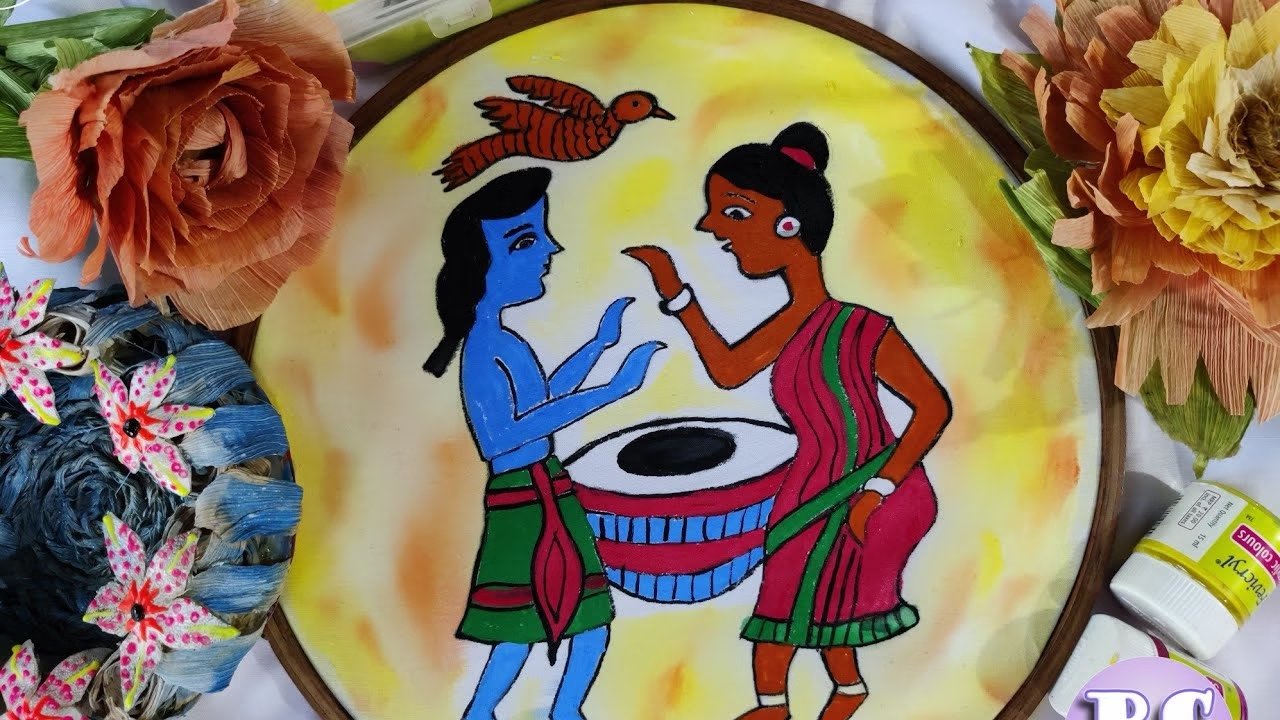
Leave a Reply